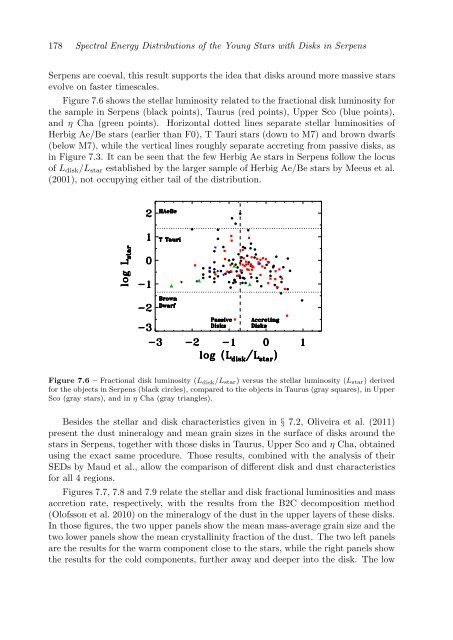Observational Constraints on The Evolution of Dust in ...
Observational Constraints on The Evolution of Dust in ...
Observational Constraints on The Evolution of Dust in ...
You also want an ePaper? Increase the reach of your titles
YUMPU automatically turns print PDFs into web optimized ePapers that Google loves.
178 Spectral Energy Distributi<strong>on</strong>s <strong>of</strong> the Young Stars with Disks <strong>in</strong> Serpens<br />
Serpens are coeval, this result supports the idea that disks around more massive stars<br />
evolve <strong>on</strong> faster timescales.<br />
Figure 7.6 shows the stellar lum<strong>in</strong>osity related to the fracti<strong>on</strong>al disk lum<strong>in</strong>osity for<br />
the sample <strong>in</strong> Serpens (black po<strong>in</strong>ts), Taurus (red po<strong>in</strong>ts), Upper Sco (blue po<strong>in</strong>ts),<br />
and η Cha (green po<strong>in</strong>ts). Horiz<strong>on</strong>tal dotted l<strong>in</strong>es separate stellar lum<strong>in</strong>osities <strong>of</strong><br />
Herbig Ae/Be stars (earlier than F0), T Tauri stars (down to M7) and brown dwarfs<br />
(below M7), while the vertical l<strong>in</strong>es roughly separate accret<strong>in</strong>g from passive disks, as<br />
<strong>in</strong> Figure 7.3. It can be seen that the few Herbig Ae stars <strong>in</strong> Serpens follow the locus<br />
<strong>of</strong> L disk /L star established by the larger sample <strong>of</strong> Herbig Ae/Be stars by Meeus et al.<br />
(2001), not occupy<strong>in</strong>g either tail <strong>of</strong> the distributi<strong>on</strong>.<br />
Figure 7.6 – Fracti<strong>on</strong>al disk lum<strong>in</strong>osity (L disk /L star) versus the stellar lum<strong>in</strong>osity (L star) derived<br />
for the objects <strong>in</strong> Serpens (black circles), compared to the objects <strong>in</strong> Taurus (gray squares), <strong>in</strong> Upper<br />
Sco (gray stars), and <strong>in</strong> η Cha (gray triangles).<br />
Besides the stellar and disk characteristics given <strong>in</strong> § 7.2, Oliveira et al. (2011)<br />
present the dust m<strong>in</strong>eralogy and mean gra<strong>in</strong> sizes <strong>in</strong> the surface <strong>of</strong> disks around the<br />
stars <strong>in</strong> Serpens, together with those disks <strong>in</strong> Taurus, Upper Sco and η Cha, obta<strong>in</strong>ed<br />
us<strong>in</strong>g the exact same procedure. Those results, comb<strong>in</strong>ed with the analysis <strong>of</strong> their<br />
SEDs by Maud et al., allow the comparis<strong>on</strong> <strong>of</strong> different disk and dust characteristics<br />
for all 4 regi<strong>on</strong>s.<br />
Figures 7.7, 7.8 and 7.9 relate the stellar and disk fracti<strong>on</strong>al lum<strong>in</strong>osities and mass<br />
accreti<strong>on</strong> rate, respectively, with the results from the B2C decompositi<strong>on</strong> method<br />
(Ol<strong>of</strong>ss<strong>on</strong> et al. 2010) <strong>on</strong> the m<strong>in</strong>eralogy <strong>of</strong> the dust <strong>in</strong> the upper layers <strong>of</strong> these disks.<br />
In those figures, the two upper panels show the mean mass-average gra<strong>in</strong> size and the<br />
two lower panels show the mean crystall<strong>in</strong>ity fracti<strong>on</strong> <strong>of</strong> the dust. <strong>The</strong> two left panels<br />
are the results for the warm comp<strong>on</strong>ent close to the stars, while the right panels show<br />
the results for the cold comp<strong>on</strong>ents, further away and deeper <strong>in</strong>to the disk. <strong>The</strong> low
















